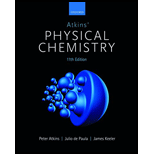
Interpretation:
The ratio of the population of the levels with J=2 and J=1 of HCl at 25οC has to be calculated.
Concept introduction:
Statistical
q≡∑igie−β∈i
It is also known as canonical ensemble partition function.
Answer to Problem 13A.1ST
The ratio of the population of the levels with J=2 and J=1 of HCl at 25οC is 1.359_.
Explanation of Solution
The expression for the energy of the state with quantum number J is shown below.
εJ=hc˜BJ(J+1) (1)
Where,
- h is Plank’s constant.
- c is the velocity of light.
- ˜B is rotational constant.
- J is the rotational quantum number.
The energy of the state with quantum number J=1 is calculated by substituting J=1 in equation (1) as shown below.
ε1=hc˜B×1(1+1)=2hc˜B
The energy of the state with quantum number J=2 is calculated by substituting J=2 in equation (1) as shown below.
ε2=hc˜B×2(2+1)=6hc˜B
The expression for the Boltzmann population ratio is shown below.
NiNj=e−β(εi−εj) (2)
Where,
- NiNj is the ratio of the population of the upper state and lower state.
- εi is the energy of the state with a quantum number i.
- εj the energy of the state with a quantum number j.
- β=1/kT, here k is Boltzmann’s constant and T is the temperature.
The energy separation of the states with J=2 and J=1 is shown below.
ε2−ε1=6hc˜B−2hc˜B=4hc˜B
Substitute the values of i=2 and j=1 in equation (2) as shown below.
N2N1=e−β(ε2−ε1)
Substitute the value of ε2−ε1 in the above equation.
N2N1=e−4hc˜Bβ
The upper level with rotational quantum number has five-fold degeneracy and the lower level has three-fold degeneracy. So the relative population of the levels is calculated as shown below.
N2N1=53e−4hc˜Bβ
Substitute β=1/kT in the above equation as shown below.
N2N1=53e−4hc˜BkT (3)
The value of kT/hc is 207.22 cm−1 at 25οC and the value of ˜B is 10.591 cm−1. Substitute the value of kT/hc and ˜B in equation (3) as shown below.
N2N1=53e−4hc˜BkT=53e−4×10.591 cm−1207.22 cm−1=53e−42.364207.22=53e−0.204
The above equation is further solved as shown below.
N2N1=53e−0.204=53×0.8154=1.359_
Therefore, the ratio of the population of the levels with J=2 and J=1 of HCl at 25οC is 1.359_.
Want to see more full solutions like this?
Chapter 13 Solutions
Atkins' Physical Chemistry
- CHEM2323 Problem 2-24 Tt O e: ל Predict the product(s) of the following acid/base reactions. Draw curved arrows to show the formation and breaking of bonds. If the bonds needed are not drawn out, you should redraw them. + BF3 (a) (b) HI + (c) OH -BF Problem 2-25 Use curved arrows and a proton (H+) to draw the protonated form of the following Lewis bases. Before starting, add all missing lone pairs. (a) (b) :0: (c) N 1 CHEM2323 PS CH02 Name:arrow_forwardCHEM2323 Problem 2-26 Tt O PS CH02 Name: Use the curved-arrow formalism to show how the electrons flow in the resonance form on the left to give the one on the right. (Draw all lone pairs first) (a) NH2 NH2 + (b) Problem 2-27 Double bonds can also act like Lewis bases, sharing their electrons with Lewis acids. Use curved arrows to show how each of the following double bonds will react with H-Cl and draw the resulting carbocation. (a) H2C=CH2 (b) (c) Problem 2-28 Identify the most electronegative element in each of the following molecules: (a) CH2FCI F Problem 2-29 (b) FCH2CH2CH2Br (c) HOCH2CH2NH2 (d) CH3OCH2Li F 0 0 Use the electronegativity table in Figure 2.3 to predict which bond in the following pairs is more polar and indicate the direction of bond polarity for each compound. (a) H3C-Cl or Cl-CI (b) H3C-H or H-CI (c) HO-CH3 or (CH3)3Si-CH3 (d) H3C-Li or Li-OHarrow_forwardDon't used hand raitingarrow_forward
- Don't used hand raitingarrow_forwardat 32.0 °C? What is the osmotic pressure (in atm) of a 1.46 M aqueous solution of urea [(NH2), CO] at 3 Round your answer to 3 significant digits.arrow_forwardReagan is doing an atomic absorption experiment that requires a set of zinc standards in the 0.4-1.6 ppm range. A 1000 ppm Zn solution was prepared by dissolving the necessary amount of solid Zn(NO3)2 in water. The standards can be prepared by diluting the 1000 ppm Zn solution. Table 1 shows one possible set of serial dilutions (stepwise dilution of a solution) that Reagan could perform to make the necessary standards. Solution A was prepared by diluting 5.00 ml of the 1000 ppm Zn standard to 50.00 ml. Solutions C-E are called "calibration standards" because they will be used to calibrate the atomic absorption spectrometer. a. Compare the solution concentrations expressed as ppm Zn and ppm Zn(NO3)2. Compare the concentrations expressed as M Zn and M Zn(NO3)2 - Which units allow easy conversion between chemical species (e.g. Zn and Zn(NO3)2)? - Which units express concentrations in numbers with easily expressed magnitudes? - Suppose you have an analyte for which you don't know the molar…arrow_forward
 ChemistryChemistryISBN:9781305957404Author:Steven S. Zumdahl, Susan A. Zumdahl, Donald J. DeCostePublisher:Cengage Learning
ChemistryChemistryISBN:9781305957404Author:Steven S. Zumdahl, Susan A. Zumdahl, Donald J. DeCostePublisher:Cengage Learning ChemistryChemistryISBN:9781259911156Author:Raymond Chang Dr., Jason Overby ProfessorPublisher:McGraw-Hill Education
ChemistryChemistryISBN:9781259911156Author:Raymond Chang Dr., Jason Overby ProfessorPublisher:McGraw-Hill Education Principles of Instrumental AnalysisChemistryISBN:9781305577213Author:Douglas A. Skoog, F. James Holler, Stanley R. CrouchPublisher:Cengage Learning
Principles of Instrumental AnalysisChemistryISBN:9781305577213Author:Douglas A. Skoog, F. James Holler, Stanley R. CrouchPublisher:Cengage Learning Organic ChemistryChemistryISBN:9780078021558Author:Janice Gorzynski Smith Dr.Publisher:McGraw-Hill Education
Organic ChemistryChemistryISBN:9780078021558Author:Janice Gorzynski Smith Dr.Publisher:McGraw-Hill Education Chemistry: Principles and ReactionsChemistryISBN:9781305079373Author:William L. Masterton, Cecile N. HurleyPublisher:Cengage Learning
Chemistry: Principles and ReactionsChemistryISBN:9781305079373Author:William L. Masterton, Cecile N. HurleyPublisher:Cengage Learning Elementary Principles of Chemical Processes, Bind...ChemistryISBN:9781118431221Author:Richard M. Felder, Ronald W. Rousseau, Lisa G. BullardPublisher:WILEY
Elementary Principles of Chemical Processes, Bind...ChemistryISBN:9781118431221Author:Richard M. Felder, Ronald W. Rousseau, Lisa G. BullardPublisher:WILEY





